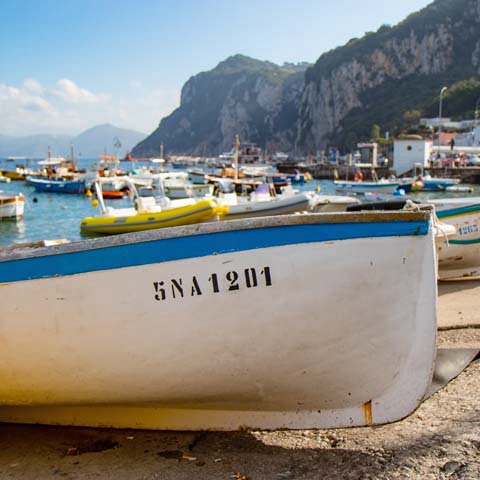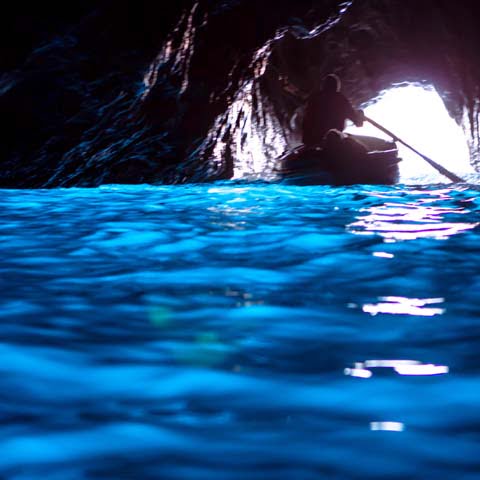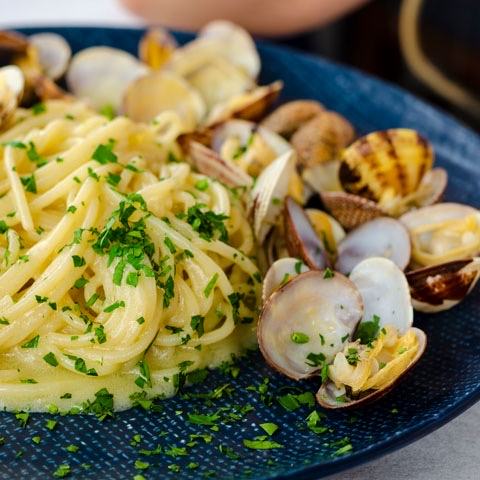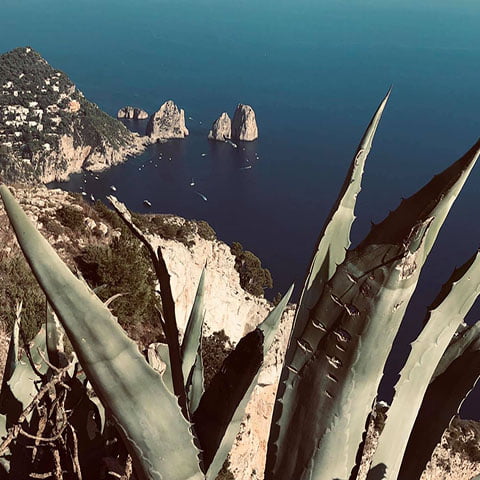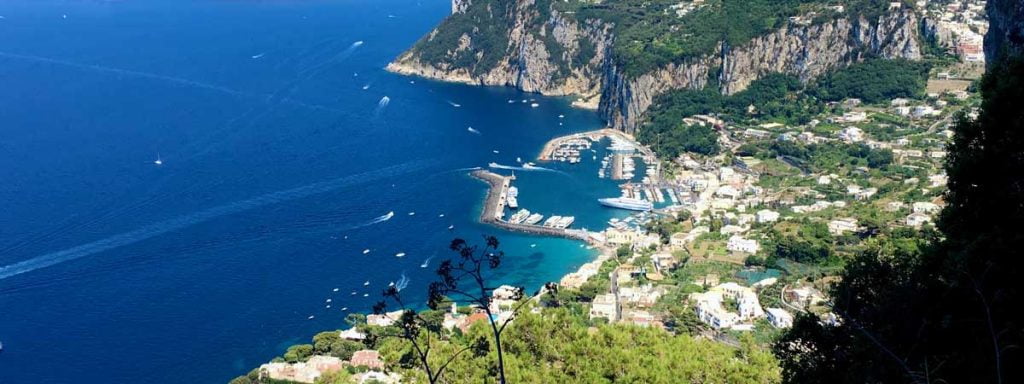Archaeological evidence suggests that the island of Capri has been settled since the Bronze, or possibly even as far back as the Neolithic age. However, historical records of Capri only truly start becoming prominent dating back to the eighth century BC, when it was settled by the Greeks and the Phoenicians.
Capri gained prominence during the age of the Roman Empire, when Emperor Augustus worked to develop and modernize the island for the citizens of Rome. The island quickly became a vacation spot for wealthy Roman statesmen. Later, Augustus’s successor, Emperor Tiberius, decided to build twelve villas named after the Roman gods upon it. Emperor Tiberius ruled the Roman Empire from Villa Jovis (or Villa of Jupiter) on Capri from 27 AD until his death in 37 AD.
After the fall of the Roman Empire, the island of Capri fell under the control of the city of Naples. However, despite ostensibly being under their protection, Naples generally left Capri to its own devices. Unfortunately, this led to the island becoming a prime target for attacks by pirates. Many of the inhabitants, who up to that point had generally relied on fishing for survival, were forced inland onto the mountain, where they settled upon the west face of Monte Solaro; a settlement that would eventually become the town of Anacapri.
Over the ensuing centuries, Capri would change hands many times. Between the years of 1200 and 1500, the island fell under the control of the Normans, then the Swabians, then the Spanish. Eventually, the Ottoman Empire would wrest control of the island, before it finally was taken over by the French. Capri would remain under French control, serving as a naval base for Napoleon’s forces in the late eighteenth and early nineteenth centuries, until the end of the Napoleonic era in 1815.
It was during the 19th century that the people of Europe truly discovered Capri’s potential as a resort destination. Wealthy industrialists and businessmen, along with famous artists, authors, and other celebrities began to flock to the island in droves. Natural scientists also took an interest in the island, studying the biology of the natural flora and fauna of Capri, as well as diving into the archaeological mysteries the island held. Famous celebrities and the rich and powerful have been coming to Capri ever since, making it one of the premiere travel destinations in the world.
Nowadays, Capri has a sense of duality about it, with its trendy and modern atmosphere that the many travelers, artists, and celebrities bring to the island, as well as the ancient and storied history of the island dating back to antiquity.
ART
Keeping true to its dualistic nature, Capri has several art museums filled with both antiquated and modern pieces of art. For those looking for religious art, one cannot miss the Church of San Michele in Anacapri. Here, one can marvel at some of the most beautiful mosaics in the world depicting the ejection of Adam and Eve from the Garden of Eden. One can also visit the Villa San Michele, constructed by the Swedish physician Axel Munthe in 1887, which contains an amazing collection of over 1,600 pieces of art from the years 1250 to 1900.
If one prefers more modern art, Capri has that covered as well. Some of these museums include the Studio Lab and the White Room, among others. With the number of artists that come to Capri for inspiration and a place to show off their pieces, there is always something fascinating to see.
ARCHITECTURE IN CAPRI ITALY
The island of Capri was not as heavily influenced by the Renaissance as most other places in Italy, due to being under the control of foreign forces throughout most of that era. However, that does not mean that there is not anything to see in Capri. While grand sweeping cathedrals are mostly absent, one can take in the remaining architecture of antiquity by viewing the Villa Jovis, where Emperor Tiberius ran the Roman Empire for a decade.
Emperor Tiberius was one of the first travelers to fall in love with the island of Capri. In fact, Villa Jovis is one among 12 villas he constructed on the island. Covering approximately 75,000 square feet, Villa Jovis was certainly the grandest of Tiberius’s island residences. The villa is located on a promontory, subsequently named Mount Tiberius Promontory, that offers spectacular views of the Gulf of Naples. The villa is an interesting example of Roman architecture because it contains both traditional elements of Roman villas as well as characteristics of a fortress. A particular aspect of the design are the cisterns that collected rainwater, which was used as drinking water and as part of the villa’s bath system. Because Capri contains no natural springs, these cisterns were vital.
There are also numerous churches and villas to explore scattered throughout the island, particularly near Anacapri.
Dating back to the fourteenth century, the Charterhouse of San Giacomo, a Carthusian monastery, is among the oldest structures on the island. The complex is composed of three main parts that include the annex (with a pharmacy and women’s chapel), a lay building (with storage areas, workshops, and stables), and the cloisters (consisting of the Greater Cloister and the Lesser Cloister). Unfortunately, history was not very kind to the Charterhouse. During the sixteenth century, the complex suffered great damage at the hands of numerous pirate raids. Restoration works followed in the seventeenth century, but were interrupted by the invading French forces. During this period the Charterhouse was used as military barracks as well as a hospital and prison. Thankfully, the first half the twentieth century brought a new series of renovation works that restored the charterhouse to its original medieval splendor. The gardens adjacent to the Charterhouse are a favorite among visitors thanks to the spectacular views of the Faraglioni and the sea.
Another important religious structure is Santo Stefano, which served as the Cathedral of Capri until the island was moved under the jurisdiction of the Archdiocese of Sorrento-Castellammare di Stabia during the eighteenth century. Constructed at the end of the seventeenth century, the Church of Santo Stefano is the largest church on the island. The stately façade features Baroque sculptures and stucco decorations. Inside, the floor of the church consists of multi-colored marble, which was sourced from Villa Jovis. The chapels are richly decorated and feature works by artists such as Giacomo Farelli and Giacomo Colombo.
Among the island’s more recent secular structures, Villa Lysis is a must-see. Constructed during the twentieth century by a French nobleman, novelist, and poet named Jacques d’Adelswärd-Fersen, the villa served as a secluded getaway for its owner. Over the years, countless poets, artists, and writers who visited Capri would admire Villa Lysis and commemorate its beauty in their work. The ornate architecture and decorations of the villa have several key influences including French aristocratic style, Neoclassicism, Art Nouveau, and Asian designs. The beautiful architecture is complemented by the remarkable views that can be enjoyed from the villa’s clifftop position.
Along Capri’s southwestern coast, travelers can catch a glimpse of the Punta Carena Lighthouse. Constructed in the nineteenth century, the distinct architecture of the lighthouse consists of an octagonal brick tower that can be spotted from different points on the island and while exploring the coast.
One of the most scenic ways to reach Anacapri from Capri is to climb the Phoenician Steps. Despite their name, this extensive stone stairway was most likely constructed by the ancient Greeks. For many years prior to the completion of the island’s main road, these steep steps were the only means of travel between Anacapri and Capri. Composed of nearly 1,000 steps that span approximately one mile, this strenuous ascent rewards travelers with beautiful panoramic views.
For those that appreciate more modern architecture, one can visit Casa Malaparte on the eastern side of Capri. Built around 1937 by the famous Italian architect Adalberto Libera for his patron, the author and filmmaker Curzio Malaparte, it is considered one of the greatest examples of Italian modern architecture, and is only about an hour and a half walk from Piazza Umberto I.
LITERATURE
Capri has inspired numerous authors over the years. Among the many distinguished people who have come to Capri for relaxation and inspiration are such diverse characters as British writer Norman Douglas, the aforementioned writers Jacques d’Adelswärd-Fersen and writer Curzio Malaparte, as well as Soviet author Maxim Gorky, who even hosted Lenin in his villa for a time in the early days of the Soviet Union. To this day, you can still visit many of the villas and houses that these creative minds spent their days working at.
CINEMA FROM CAPRI
The iconic island of Capri has served as a set for several Italian and international films over the decades including The Emperor of Capri (1949), Bellezze a Capri (1952), Avventura a Capri (1959), It Started in Naples (1960), Contempt (1963), Il secondo tragico Fantozzi (1976), La pelle (1981), and Un’estate al mare (2008).
Many classic actors and actresses of the silver screen, such as Audrey Hepburn and Grace Kelly, would vacation in Capri, contributing to the island’s glamorous atmosphere and jet set allure.
What’s more, Capri still plays host to many filmmakers and movie stars today. It is not an uncommon sight to be walking along Piazza Umberto I, or the Piazzetta as the locals call it, and spy a famous author or film director having a morning cappuccino at a nearby café.
SCIENCE
In the nineteenth century, the isle of Capri was visited by the natural scientist Ignazio Cerio. This distinguished, though eccentric Doctor of Medicine and amateur philosopher spent years studying and cataloguing the flora and fauna of Capri. He remains much loved on the island with his memory immortalized by the writings of his son Edwin Cerio.
Today, one can visit the Museum Ignazio Cerio in the town of Capri, originally founded by the doctor himself, where one can view collections featuring zoology and botany, paleontology, archaeology, and ancient history.
MUSIC IN CAPRI
Over the years, Capri’s legendary beauty has inspired Italian musicians to write equally beautiful songs, with the most notable examples being “L’isola d’oro”, which was written by iconic Italian actor Totò, and “Luna caprese” by Augusto Cesareo and Luigi Ricciardi and sung by Peppino di Capri, a native of the island.
Today, operas are hosted in the Villa San Michele, and many modern musicians and singers, including Mariah Carey, own property on the island.
Despite its small size, the island of Capri hosts an impressive collection of historic ruins, beautiful artwork, and unique architecture. Over the centuries Capri has attracted countless artists, writers, and celebrities, who have all fallen in love with this enchanting island.
Don't just see Italy, live it.
Your dream trip to Italy has never been closer
No more endlessly scrolling travel sites. Our travel experts will craft the perfect, one-of-a-kind trip just for you.

300+
DESTINATIONS
We offer more Italian destinations than any travel site. Do and see more with Trips 2 Italy.
1 (of a kind)
ITINERARIES
Because your dream trip to Italy should be designed for you, not for the masses.
100%
PEACE OF MIND
From flights and accommodations, to food and activities - we take care of every detail.
